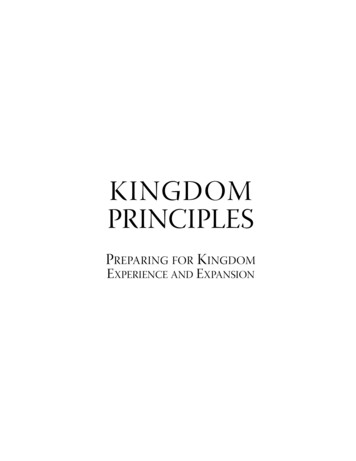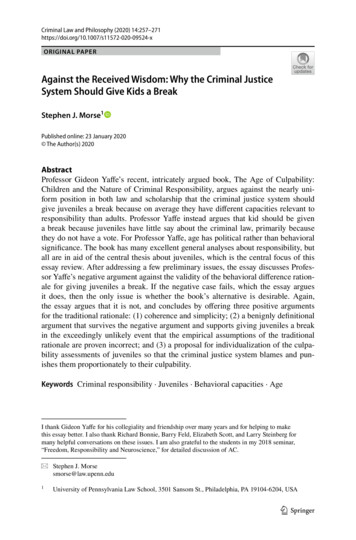
Transcription
Criminal Law and Philosophy (2020) 24-xORIGINAL PAPERAgainst the Received Wisdom: Why the Criminal JusticeSystem Should Give Kids a BreakStephen J. Morse1Published online: 23 January 2020 The Author(s) 2020AbstractProfessor Gideon Yaffe’s recent, intricately argued book, The Age of Culpability:Children and the Nature of Criminal Responsibility, argues against the nearly uni‑form position in both law and scholarship that the criminal justice system shouldgive juveniles a break because on average they have different capacities relevant toresponsibility than adults. Professor Yaffe instead argues that kid should be givena break because juveniles have little say about the criminal law, primarily becausethey do not have a vote. For Professor Yaffe, age has political rather than behavioralsignificance. The book has many excellent general analyses about responsibility, butall are in aid of the central thesis about juveniles, which is the central focus of thisessay review. After addressing a few preliminary issues, the essay discusses Profes‑sor Yaffe’s negative argument against the validity of the behavioral difference ration‑ale for giving juveniles a break. If the negative case fails, which the essay arguesit does, then the only issue is whether the book’s alternative is desirable. Again,the essay argues that it is not, and concludes by offering three positive argumentsfor the traditional rationale: (1) coherence and simplicity; (2) a benignly definitionalargument that survives the negative argument and supports giving juveniles a breakin the exceedingly unlikely event that the empirical assumptions of the traditionalrationale are proven incorrect; and (3) a proposal for individualization of the culpa‑bility assessments of juveniles so that the criminal justice system blames and pun‑ishes them proportionately to their culpability.Keywords Criminal responsibility · Juveniles · Behavioral capacities · AgeI thank Gideon Yaffe for his collegiality and friendship over many years and for helping to makethis essay better. I also thank Richard Bonnie, Barry Feld, Elizabeth Scott, and Larry Steinberg formany helpful conversations on these issues. I am also grateful to the students in my 2018 seminar,“Freedom, Responsibility and Neuroscience,” for detailed discussion of AC.* Stephen J. Morsesmorse@law.upenn.edu1University of Pennsylvania Law School, 3501 Sansom St., Philadelphia, PA 19104‑6204, USA13Vol.:(0123456789)
258Criminal Law and Philosophy (2020) 14:257–2711 IntroductionHere is the opening of the summary of an amicus brief in Roper v. Simmons, the2005 United States Supreme Court decision holding the death penalty unconstitu‑tional for all juvenile capital offenders. It was filed by, inter alia, the American Med‑ical Association, the American Psychiatric Association, the American Academy ofChild and Adolescent Psychiatry, and the American Academy of Psychiatry and theLaw:The adolescent’s mind works differently from ours. Parents know it. ThisCourt [the United States Supreme Court] has said it. Legislatures have pre‑sumed it for decades or more.1This blinding insight was confirmed in Miller v. Alabama, which held that man‑datory life imprisonment for juvenile offenders who had committed homicidecrimes is unconstitutional. In dissent, Chief Justice Robert said, “[ ] teenagers areless mature, less responsible, and less fixed in their ways than adults—not that aSupreme Court case was needed to establish that.”2Precisely. The common law of immaturity in a wide variety of criminal and civilcontexts and the establishment of a juvenile court system in the 19th C. confirm thatthe law has long responded to the psychological differences between juveniles andadults. Indeed, Roman law instantiated the difference and the English common lawof infancy has its roots in the 14th C.3 The age of majority has varied from time totime. In the mature common law of criminal responsibility, kids4 younger than 7were conclusively presumed to be not responsible, kids 7–13 were rebuttably pre‑sumed not responsible, and kids 14 and older were presumed responsible. Today,the dividing line in the United States for most purposes is 18 and varies for crimi‑nal responsibility; in English law, the age of criminal responsibility is 12. But theimportant culpability and competence differences between those older and youngerthan the dividing line were always assumed.It was equally and always assumed, implicitly or explicitly, that those differencesand the differential legal treatment that followed were based on differences in thecapacities of the two groups, such as the alleged greater average impulsiveness ofkids, which could vary according to the context. Committing a serious crime anddeciding whether to have an abortion are different behaviors that seem to requiredifferent capacities for responsibility. Differences may be more important for somelegal categories than for others. Age is allegedly a good but imperfect proxy forthese differences. Virtually all important juvenile law scholars, such as David Brink,Barry Feld, Elizabeth Scott, Laurence Steinberg, Franklin Zimring, and a host of1Brief of the American Medical Association et al. as Amici Curiae in Support of Respondentat 2, Roper v. Simmons, 543 U.S. 551 (2005).2Miller v. Alabama, 567 U.S. 460, 493 (2012) (Roberts, C.J., dissenting).3A. W. G. Kean, “The History of the Criminal Liability of Children,” 53 L. Q. Rev. 364 (1937).4I would prefer to use a different term, such as minors or youths, but AC uses “kids” and so shall I.13
Criminal Law and Philosophy (2020) 14:257–271259others agree. This was, and still is, the received wisdom.5 Let us refer to this as TheReceived Wisdom [TRW], recognizing that it may have different forms. TRW hasbeen substantially bolstered in recent years by increasingly sophisticated behavioralscience that confirms substantial behavioral differences on average between adultsand adolescents, many of which are relevant to classic responsibility criteria such asrationality broadly conceived, and by neuroimaging studies demonstrating that thebrain’s anatomical maturation does not end at any of the usual legal dividing linesbut continues into the mid-20s.Arguing against TRW, Gideon Yaffe’s The Age of Culpability [AC], an immenselyrigorous account of why kids should be given a break for criminal responsibility,suggests that everyone else has provided the wrong rationale for differential criminaljustice treatment. TRW is so entrenched that, to the best of my knowledge, AC is theonly serious counterargument ever offered for giving kids a break. According to AC,the reason kids deserve a break does not depend on different capacities, but insteadis better justified on the basis that kids generally have much less say about the legalcriteria for criminal responsibility, primarily because they do not have the right tovote. AC argues that kids should be given a break because Yaffe’s reason-responsiveview of criminal responsibility entails that they have fewer legal reasons to obeythan adults and are therefore less culpable. AC argues that age has political meaningrather than significance because it betokens behavioral capacity differences.This creative and intricately argued volume has many interesting chapters thatdeploy original and nuanced arguments that develop AC’s theory of responsibility,especially the chapters on culpability and desert. These are challenging and interest‑ing in themselves and less (but still quite) controversial than the argument about giv‑ing kids a break. They should be read by all those interested in criminal culpabilitygenerally. I suspect that this wider theory of responsibility is AC’s major quarry anddeserves its own review. Nonetheless, the general theory is nominally in aid of thevolume’s basic goal of re-orienting how we should think about giving kids a break.Because the primary goal is re-thinking why the criminal justice system should treatkids differently, this essay will therefore focus on that question.The question for criminal law theorists is whether TRW or AC’s rationale is abetter positive explanation and more normatively desirable. AC’s argument is laby‑rinthinely complicated. Ockham’s razor is dulled with every stroke. It is so denselyargued that a review that does it justice would be as long as the book, and perhapslonger. This is unsurprising when one is seeking to upend the legal, scholarly andcommonsense wisdom (or lack of it) of millennia by philosophical argument ratherthan by empirical disproof. A great deal of heavy lifting will be necessary. By itself,the intricacy of the necessary argumentation and the hoary countervailing history donot mean that AC is wrong. But AC clearly has the burden of persuasion on histori‑cal and methodological grounds. In this case, I am not persuaded: TRW is a betterfit to the data and furnishes a more appealing ground for giving kids a break than5This assertion is implicitly accepted in Gideon Yaffe, The Age of Culpability: Children and the Natureof Criminal Responsibility, at 28, n.8. Oxford University Press, 2018 (hereinafter “AC”), which volumeis the subject of this essay.13
260Criminal Law and Philosophy (2020) 14:257–271lack of say over the criminal law. TRW holds that the law gives kids less say becauseon average they are less rational and experienced than adults. Indeed, that is theresponse that virtually all people have when hearing AC’s argument.AC rightly and usefully notes that there are three independent positive argumentsfor treating kids differently: age is a proxy for diminished culpability, kid will bekids, and kids will grow out of it. It also correctly observes that some advocates forTRW conflate the three. Nevertheless, the proxy argument is the most common andimportant position. After addressing a few preliminary issues, I therefore discussAC’s negative argument against the validity of TRW, focusing on the diminishedculpability claim, especially because the structure of the negative argument againstthe other two is structurally similar and because it is unclear that kids will be kids isa genuinely independent argument. I conclude that the negative argument does notsucceed.If the negative case against TRW fails, as I claim, then the only issue is whetherAC’s alternative is desirable. Again, the essay argues that it is not, and concludesby offering three positive arguments for the traditional rationale: (1) coherence andsimplicity; (2) a benignly definitional argument that survives the negative argumentand supports giving all juveniles a break in the exceedingly unlikely event that theempirical assumptions of the traditional rationale are proven incorrect; and (3) a pro‑posal for individualization of the culpability assessments of juveniles who commitserious crimes so that the criminal justice system blames and punishes them propor‑tionately to their culpability. Throughout, my primary goal is not to take issue withAC, although it will seem that way, but to offer what I hope are helpful thoughtsabout how kids should be treated in the criminal justice system.2 PreliminariesAC’s argument is ahistorical. As the Introduction noted, kids have been treated dif‑ferently from adults in civil and criminal law going back to Roman law. The differ‑ence in contractual obligations is a primary example. The explanation is virtuallyalways that kids have lesser capacities than adults. To continue the example of con‑tracts, kids are more likely to have bad judgment and to be more easily taken advan‑tage of because they are less rational and experienced. It is highly unlikely that kidsmay avoid their contracts in most instances because they have little say over contractlaw. It is of course possible that criminal liability is distinguishable from civil dutiesand protections, but where the law seems uniform in differential treatment and foruniform reasons—to wit, some version of TRW—drawing that distinction wouldhave strengthened AC’s case.It is important to clarify a point that advocates for kids who base their argumentson TRW often confuse. Finding an average psychological or biological differencebetween kids and adults, even a big one, does not entail different legal treatment.First, the difference must be relevant to the issue at hand, criminal responsibilityin this case. Second, even if the difference is relevant, it must be sufficiently largenormatively to justify differential legal treatment. The most egregious example ofthe first problem is the belief that neuroanatomical maturation differences between13
Criminal Law and Philosophy (2020) 14:257–271261adolescents and adults entail lesser responsibility for the former. Neuroanatomi‑cal maturation is not a relevant responsibility characteristic, however. The criteriafor responsibility are behavioral, namely acts and mental states. The claim basedon neuroanatomy is a category error. AC scrupulously and correctly does not makethis mistake. It says that neural facts, if they matter at all, only do so if they under‑lie a psychological state or capacity that does matter.6 An example of the secondis impulsivity. The Supreme Court and many others seem to think that impulsivitydiminishes responsibility, but it is not a defense to criminal conduct and it would notbe a standard mitigating factor in adult sentencing. Consequently, there seems to bea relevance problem. But let’s assume that the Supreme Court is right. In that case,is the average impulsivity difference between adolescents and adults large enoughto justify lesser criminal responsibility for adolescents as a class? Maybe or maybenot, depending on what the legislature or the courts believe is the minimum for fullresponsibility. Even if TRW is the best justification for treating kids differently, thesetwo issues must be faced forthrightly without begging the question.AC addresses the proxy argument with a clarifying analysis of the costs andbenefits of any legal scheme that is perhaps the most penetrating that I have read.It correctly recognizes, as all sensible TRW advocates concede, that the behavio‑ral characteristics that are relevant to responsibility will be both over-inclusive andunder-inclusive no matter where we draw the dividing line, at least among adoles‑cents. Some kids below the line will have the relevant responsibility characteristicsand some adults over it will not, raising the possibility of true and false positivesand negatives in decision-making. AC cautions that any adequate policy analysismust therefore include a full assessment of all the true and false positives and nega‑tives and cannot simply focus on the virtues of the true positives, as AC accuses theSupreme Court of doing in Miller.Where, given our values, the age line should be drawn in any legal context, suchas criminal responsibility, will depend on the full costs and benefits. Neverthe‑less, because no proxy is perfect, there will be undoubted costs wherever the lineis drawn. We should recognize that no legislature will be perfectly able to do thatfull accounting. After holding hearings and presumably listening to experts as wellas pressure groups, the legislature will fly by the empirical seat of its pants. Among“equally implementable” alternatives, to use AC’s phrase—and in this instance theage lines are all equally implementable—we can never be absolutely sure which isthe best, nor should we expect such certainty. As Bismarck observed, watching leg‑islation and sausage being made are very similar endeavors. Neither is much likedeveloping armchair theory.Before turning to AC’s substantive criticism of the proxy argument, it is impor‑tant to recognize what a false positive means in juvenile cases and its systemiceffects. A psychologically mature minor who does not really deserve a break accord‑ing to TRW will get one, but that does not mean the juvenile goes entirely free.Instead the juvenile will receive diminished blame and punishment, but he or shewill still be punished and often substantially for serious crimes. Thus, retribution,6AC, p. 20.13
262Criminal Law and Philosophy (2020) 14:257–271deterrence and incapacitation in appropriate cases will be served, albeit not as fullyas if the kid did not get a break. But how much marginal retribution, deterrenceand incapacitation will be lost with such false positives? I do not know the answerand neither does anyone else, but would it be so objectionable if some young peo‑ple were not subjected to the full deserved afflictive imposition of state blame andpunishment?3 The Negative Argument Against TRW AC’s negative argument, which it terms the “empirical dependence” claim, startswith an intuition Professor Yaffe believes is widely shared: Even if the best behav‑ioral science were to indicate unquestionably that there were no substantial respon‑sibility-relevant differences between kids and adults or even if there were an equallyimplementable policy with a better mix of gains and losses that would not give allkids a break, we would still want to give all kids below the age cut-off line a break.AC concedes that a “no differences” finding is exceedingly unlikely scientifically;indeed the increasing accumulation of scientific information continues to confirmthe differences. But if it turned out to be true, it would make no difference. Wewould still want to give all kids a break. AC confidently asserts that the proxy forculpability argument therefore must be false and that the true ground for categori‑cally giving kids a break is to be found in some other rationale.With respect, I do not share that intuition, nor did all but one of the students inmy “Freedom and Responsibility” seminar with upper division Penn Law students.What AC terms “our implicit and unarticulated rational for giving kids a break”7 isperhaps not nearly as widely-shared as AC believes and empirical dependence is notnearly as problematic as it avers. Average capacity differences are not a metaphysi‑cal or conceptual truth about kids of any age. They are empirically grounded andcould turn out to vanish upon further investigation. (If they did, would you believethe studies or your lying eyes?) As a practical matter, however, differential capacityis not contingent although in principle, as AC rightly argues, it is. It is a safe predic‑tion that these differences will endure empirically, so perhaps it’s too easy to claimthat I would stop giving all kids a break because I know I will never have to face thepossibility. But I do not think that is true for a reason prompted by the second pillarof AC’s intuition: that we would not give up on giving kids a categorical break evenif there were an equally implementable policy that had a better mix of losses andgains. I think such a policy already exists, however, individuation, and I would adoptit. I will discuss it in the last section below, but under this policy some but not allkids would get a break.But for those who accept TRW and want to give all kids a break, will AC forcethem to concede that the proxy for culpability ground fails? I think not. AC beginsby hypothesizing a not completely hypothetical scheme by which all boys under theage of 18 get a break, but girls only get a break if they are under 16 on the ground7AC, p. 33, emphasis added.13
Criminal Law and Philosophy (2020) 14:257–271263that girls mature faster and therefore do not differ from adults at an earlier age thanboys. AC admits that no one knows if, all things considered, this scheme would bepreferable in gains and losses to a gender-neutral scheme. It also allows that it mightwell be better and says that if it is, TRW adherents should accept it. AC assumes thatmost people would nevertheless recoil from this scheme, but if they do, it claims,they should reject the proxy argument or at least demand that it be supplemented.After all, the state should not be inflicting blame and punishment according to someproxy if there is a superior proxy. Gender is of course a controversial variable touse to improve the proxy argument, but it may be the most useful if one is aimingfor accuracy and efficiency in identifying those kids who deserve a break. AC givesother similar examples,8 but let us use the gender example because the argumentstructure is similar in each case. That is, it seeks to identify every possible argumentthat might support the proxy for diminished culpability and then demonstrate that itcannot be right.AC notes that attachment to giving all kids a break might be irrational if a supe‑rior proxy were found, but tries to determine if qualms about the gender-basedclassification might be both rational and consistent with the proxy argument. Inanother words, like the excellent philosopher that he is, Professor Yaffe puts maxi‑mum pressure on his own argument. For example, appealing to more general badconsequences of a policy, such as discriminating against women leading to the per‑petuation of negative stereotypes, misses the point. Consequences are not all thatmatters to criminal liability: desert is crucial. The aversion to a gender-sensitiveclassification for criminal liability cannot be properly based on this ground if genderis superior for ascribing blame and punishment. Another possibility is that genderbased classification would unequally distribute benefits and burdens. But, as ACpoints out, even giving all kids a break does that because those defendants who areadults are apportioned heavier burdens than kids, and our society believes that is justbecause there is a genuine moral difference between adults and kids. It follows thatif gender classification is superior, then there is a moral justification for the genderinequality that is as sound as the adult/youth inequality. Just blame and punishmentare essential government functions, AC rightly notes, and doing it better should leadus to adopt the superior policy of gender-sensitivity. AC completes its gender dis‑cussion by asking whether there is an exclusionary reason not to adopt the gendersensitive classification if it is more accurate, and suggests that if there is, that is why8Race is an example, AC pp. 37–38. AC notes that if race did offer a superior classification, which ACstrongly doubts, the proxy proponents would be committed to using it if the costs of false positives andnegatives were adjusted properly to respond to the dreadful history of oppression by race. AC concludesthat it would nonetheless be unacceptable, which it claims is a powerful argument against the proxy argu‑ment. AC also asserts that raising the rate of true positives would not be an improvement in this case.I have always thought that race, like death, is “different” and requires special treatment. Even if theproxy, suitably adjusted, was superior in ascribing liability, we simply cannot use it. The same argu‑ments have been raised about evidence-based sentencing and parole and the prediction of future violentconduct for purposes of involuntary civil commitment. Even if race would increase accuracy for thosepractices, there is near consensus that it should not be used. In criminal justice, there is not simply onevalue—accurate adjudication—that is at stake. In short, this argument against the proxy argument seemsunconvincing to me.13
264Criminal Law and Philosophy (2020) 14:257–271we must recoil from this type of scheme. It concludes that there is not such a rea‑son because there are permissible contexts for gender-specific policies, such as TSAemployees who must pat down passengers and because oppression based on genderis not a feature of criminal punishment.After showing why the objections to the gender proxy can be defeated, AC saysthis:[ ] my point is not that all this shows the we ought not to give breaks togirls between the ages of 16 and 18. Far from it. I think the gender sensitivepolicy should be laughed out of contention. My point is that the advocate ofthe Proxy for Culpability argument cannot laugh at it, but must instead enter‑tain the serious possibility that it is more justified by the standards informingthe Proxy for Culpability argument in the first place. This is an objection to theProxy for Culpability argument because the gender-sensitive policy is unjustified even it if offers superior classification than the policy of giving all kids abreak regardless of gender.9With respect, I do not think that gender classifications for purposes of ascribingblame and punishment are necessarily laughable, but instead are sometimes plau‑sible. Consider Section 54 of the English Coroners and Justice Act that Parliamentpassed in 2009 and went into effect in 2010,10 which replaced the traditional provo‑cation/passion doctrine for reducing an intentional homicide from murder to man‑slaughter with a new “loss of control” mitigation. If there is a “qualifying trigger”for the loss of control, a broader doctrine than traditional provocation, the questionis what degree of control can be expected of the defendant. Subsection1(c) answersthat question as follows: “(c) a person of D’s sex and age, with a normal degree oftolerance and self-restraint and in the circumstances of D, might have reacted in thesame or in a similar way to D. [emphasis supplied]”.11 In other words, English lawassumes, perhaps incorrectly but perhaps correctly, that sex is morally relevant tothe degree of self-control to expect of ordinary people because it affects morallyrelevant categories. Further, with respect, the final conclusion that the gender-basedpolicy is unjustified even if superior, is simply an ipse dixit based on the potentiallyincorrect assumption that we think all kids should be given an equal break.AC’s assumption that we all want to give all kids a break is simply an assertionnot backed by evidence and there is counter-evidence. I do not think the proxy forculpability argument has been decisively refuted.9AC, p .39, emphasis in the original.2009 Chapter 25.11After a very checkered doctrinal history of provocation/passion doctrine in the late 2 0th C and early“aughts,” Parliament was returning to the sex and age based standard of self-control the House of Lordshad adopted in Director of Public Prosecutions (DPP) v Camplin [1978] UKHL 2.1013
Criminal Law and Philosophy (2020) 14:257–2712654 The AC Rationale for Giving All Kids a BreakAC says that the thesis of the book can be summarized by a slogan: “Kids ought tobe given a break because they are disenfranchised.”12 The positive argument can bestated as follows. Kids have little say over the content of criminal law because theycannot vote, although they can influence the law by speech (if their parents or othercontrolling institutions allow them to express themselves). Therefore, when decid‑ing whether to violate a criminal law, they have less reason than adults to recognize,weigh and respond to the legal reasons not to offend, even if the offense is a clearmoral violation.13 As people who can influence the law, adults are complicit in giv‑ing themselves legal reasons to obey and in the state’s treatment of them if theyoffend. Because kids are not so complicit, they have fewer supporting reasons toobey. As a result of the absence of legal reasons, kids are less culpable and deserve acorresponding break.On average kids have much less say or potential say about the law than adults.Of course there are many adults who have little say, and some kids who may havesubstantial say because they are the children of legislators or because they becomeinvolved in a public controversy, such as the issues of gun control in the wake ofschool shootings or of climate change. But kids cannot vote, full stop, and mostadult citizens can. Moreover, parents have significant authority over how much theirchildren can speak. If culpability differences depend in large measure on how muchsay kids have compared to adults, the culpability differences and the breaks owedmust be very large. The assessment of culpability differences and the breaks givenin our system are not so large, however. For example, after Miller, kids convicted ofhomicide crimes can be sentenced to life without the possibility of parole althoughsuch a sentence may not be mandatory. AC does argue that, all things being equal,mitigation is always appropriate,14 but perhaps the implication of AC’s argument isthat the breaks should be much larger than they are now. After all, as every criminallawyer knows, the more important question for most defendants is not whether theywill be convicted, but if they will then go to jail or prison, and if so, for how long.The size of breaks matters a lot and deserved more attention in AC.The last paragraph began with the empirical assertion AC adopts that kids haveless say about the law. This is not a conceptual truth and thus it itself raises AC’sempirical dependence concern. Suppose we had some measure that operationalizeda consensual meaning of “having a say.” In that case, we would have a continuumcomparison between kids and adults that could range from kids having lots moresay by the influence of their speech to kids having essentially no say. As AC dis‑cusses, voting is not the only way to have say, although it is very important. I recog‑nize that the two extreme positions are about as empirically likely as there being nodifferences in responsibility characteristics between kids and adults, but AC wouldhave to concede it is a possibility and should consider what follows, but does not.121314AC, p. 178.AC, pp. 72–73, discussing the modes of transactions with reasons.AC, p. 204.13
266Criminal Law and Philosophy (2020) 14:257–271Consider the possibilities. If kids have no say at all, then are they culpable at all?If the answer is affirmative, then the disenfranchisement account cannot possiblybe doing all the work for why kids should be given a break. It at least must be sup‑plementing TRW or something else. The reverse is also true. If kids have a lot moresay, they are mor
258 Criminal Law and Philosophy (2020) 14:257-271 1 3 1 Introduction v.Simmons,the .
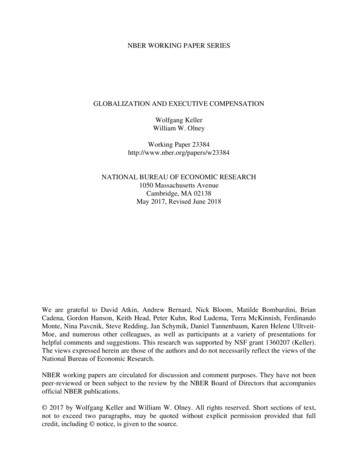
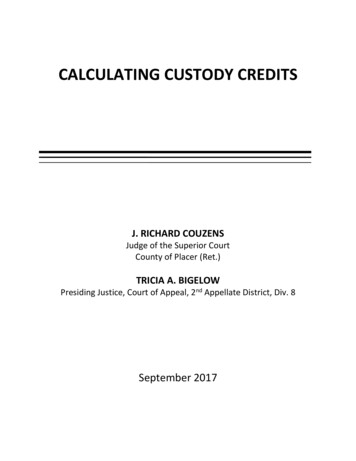
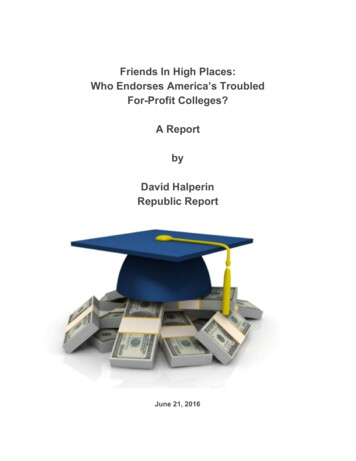
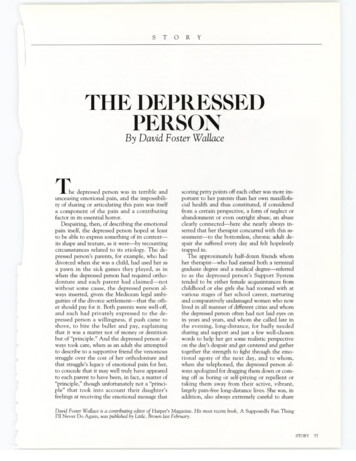

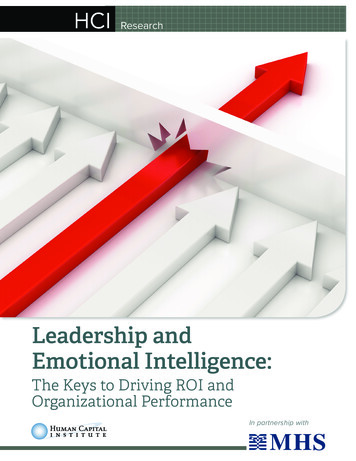
![[Page 1 – front cover] [Show cover CLEAN GET- AWAY 978-1 .](/img/13/9781984892973-6648.jpg)

